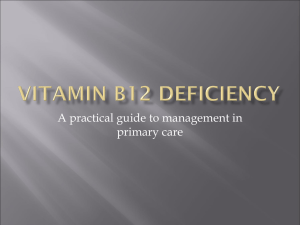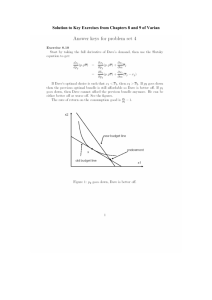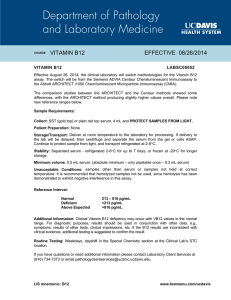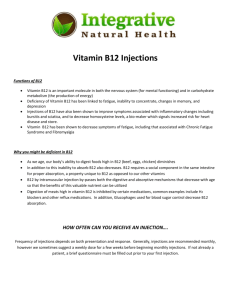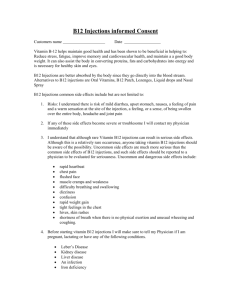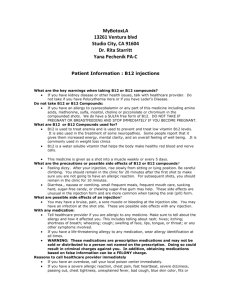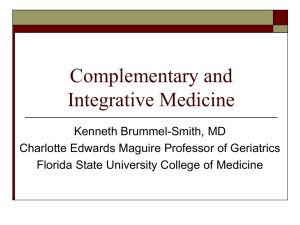August 2013 The #1 Vitamin Deficiency Damaging Your Brain
advertisement
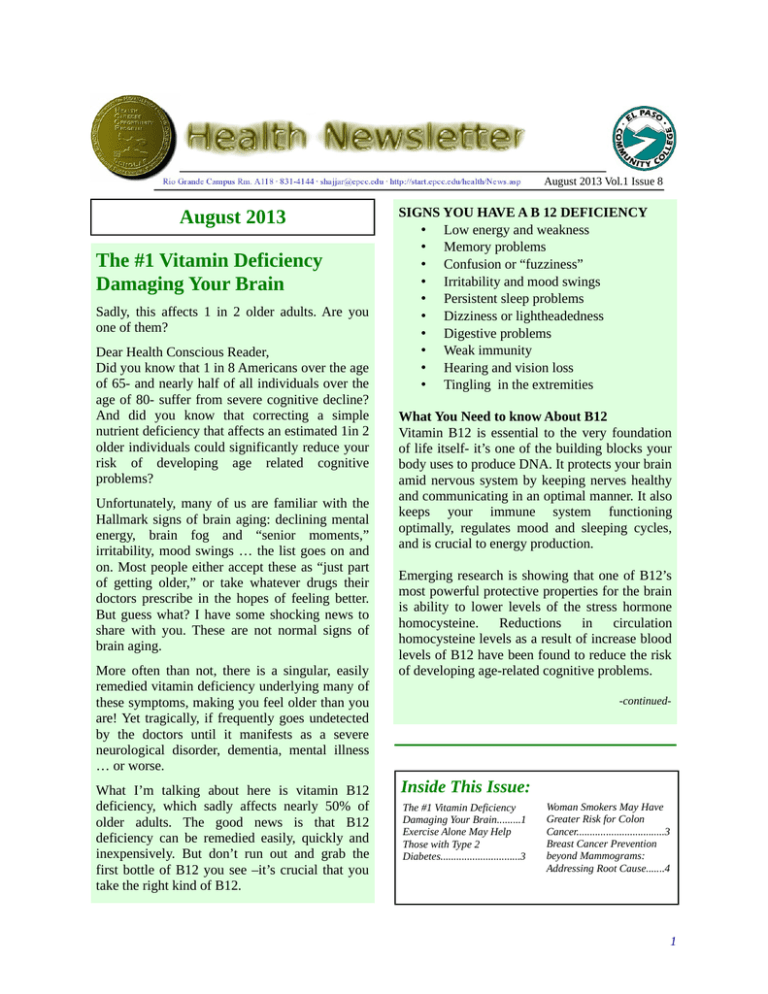
August 2013 Vol.1 Issue 8 August 2013 The #1 Vitamin Deficiency Damaging Your Brain Sadly, this affects 1 in 2 older adults. Are you one of them? Dear Health Conscious Reader, Did you know that 1 in 8 Americans over the age of 65- and nearly half of all individuals over the age of 80- suffer from severe cognitive decline? And did you know that correcting a simple nutrient deficiency that affects an estimated 1in 2 older individuals could significantly reduce your risk of developing age related cognitive problems? Unfortunately, many of us are familiar with the Hallmark signs of brain aging: declining mental energy, brain fog and “senior moments,” irritability, mood swings … the list goes on and on. Most people either accept these as “just part of getting older,” or take whatever drugs their doctors prescribe in the hopes of feeling better. But guess what? I have some shocking news to share with you. These are not normal signs of brain aging. More often than not, there is a singular, easily remedied vitamin deficiency underlying many of these symptoms, making you feel older than you are! Yet tragically, if frequently goes undetected by the doctors until it manifests as a severe neurological disorder, dementia, mental illness … or worse. What I’m talking about here is vitamin B12 deficiency, which sadly affects nearly 50% of older adults. The good news is that B12 deficiency can be remedied easily, quickly and inexpensively. But don’t run out and grab the first bottle of B12 you see –it’s crucial that you take the right kind of B12. SIGNS YOU HAVE A B 12 DEFICIENCY • Low energy and weakness • Memory problems • Confusion or “fuzziness” • Irritability and mood swings • Persistent sleep problems • Dizziness or lightheadedness • Digestive problems • Weak immunity • Hearing and vision loss • Tingling in the extremities What You Need to know About B12 Vitamin B12 is essential to the very foundation of life itself- it’s one of the building blocks your body uses to produce DNA. It protects your brain amid nervous system by keeping nerves healthy and communicating in an optimal manner. It also keeps your immune system functioning optimally, regulates mood and sleeping cycles, and is crucial to energy production. Emerging research is showing that one of B12’s most powerful protective properties for the brain is ability to lower levels of the stress hormone homocysteine. Reductions in circulation homocysteine levels as a result of increase blood levels of B12 have been found to reduce the risk of developing age-related cognitive problems. -continued- Inside This Issue: The #1 Vitamin Deficiency Damaging Your Brain.........1 Exercise Alone May Help Those with Type 2 Diabetes..............................3 Woman Smokers May Have Greater Risk for Colon Cancer.................................3 Breast Cancer Prevention beyond Mammograms: Addressing Root Cause.......4 1 August 2013 Vol.1 Issue 8 The #1 Vitamin Deficiency Damaging Your Brain (cont.) How B12 Protects Your Brain Cognitive decline is a serious concern for most of us as we get older, and the statistics are grim. The good news is that getting enough B12 can drastically cut your risk! Scientists now understand that age-related cognitive decline is linked to a process in the body that involves a decrease in brain mass. That’s right your brain actually shrinks as you age! This reduction in brain mass is directly correlated with loss of memory and cognitive function seen in older individuals. Emerging research is showing that being deficient in B12 puts your brain in serious danger, so if you care about your cognitive health, you better be sure that you’re getting enough. Recently, a landmark study showed vitamin B12 supplementation slows the accelerated rate of brain shrinking and declining cognitive scores in older individuals. Another study showed that older individuals with higher levels of B 12 in their blood had less shrinkage of the brain than counterparts with lower levels. Those with higher B 12 blood levels and increased brain size even scored higher on memory and cognitive tests! B 12 Deficiency: The Silent Epidemic Recent studies have shown that nearly 1in 2 older adults have dangerously low levels of B12. The older you are, the higher your risk, but younger people aren’t exuded from harm. Researchers found that nearly 1in 4 people over the age of 26 are at least borderline deficient in B12 and may already be experiencing symptoms as a result. The worst part is that doctors typically misdiagnose B12 deficiency symptoms and then prescribe drugs that do nothing to address the problem. But you can avoid falling into that trap. Why are so Many People B12 Deficient? It’s long been known that vegetarians are at increased risk for B12 deficiency, since B12 is only found in red meat and few other animal foods. But contrary to what some “experts” have said for years, it’s not just vegetarians who are at risk. The reason that vast majority of people end up B 12 deficient has nothing to do with B 12 in take, but rather, their ability to absorb B12 from food. As you get older, the lining of your stomach gradually loses its ability to produce hydrochloric acid, which you need to absorb B12 from food. The use of certain drugs can also lower your stomach acid secretion, further hampering B12 absorption. This is why with B12 supplements, a sublingual (under the tongue ) delivery system – which ensures the B12 goes directly into your bloodstream, bypassing your digestive tract-is absolutely essential. B12 Deficiency Can Strike Anyone, But you At Higher Risk If you... • • • • • • • • Are over the age of 45 Take acid-blocking medications Are a vegan or vegetarian Are or have ever been anemic Suffer from Digestive problem Have low stomach acid Take certain diabetes drugs Drink alcoholic beverages Source: http://liveinthenow.com/ 2 August 2013 Vol.1 Issue 8 Exercise Alone May Help Those with Type 2 Diabetes Woman Smokers May Have Greater Risk for Colon Cancer Small study found it helped even if other lifestyle changes were made Smoking increases the risk for developing colon cancer, and female smokers may have a greater risk than male smokers, according to date published in Cancer Epidemiology, Biomarkers and prevention. Globally, during the last 50 years, the number of new colon cancers cases per year has exploded for both men and women. Gram and her researchers, colleagues examined the association between cigarette smoking and colon cancer, by tumor location in a large Norwegian cohort of more than 600,000 men and women. The participants from four surveys initiated by the National Health Screening Service of the Norwegian Institute of Public Health had a short health exam and completed questionnaires about smoking habits, physical activity, and other lifestyle factors. The participants were followed by linkage to the Cancer Registry of Norway and central population Register. During an average 14 years of following, close to 4,000 new colon cancer cases were diagnosed. Gram and colleagues found that female smokers had a 19% increased risk compared with never-smokers, while male smokers had an 8% increased risk compared with never-smokers. The finding that women who smoked even a moderation number of cigarettes daily have an increased risk for colon cancer will account for a substantial number of new cases because colon cancer is such a common disease,” said Gram. A causal relationship between smoking and colorectal cancer has recently been established by the International Agency for Research on Cancer of the World Health Organization, but unfortunately, this is not yet common knowledge, neither among health personnel nor the public.” Exercise benefits with type 2diabetes even if they don’t make any other lifestyle or diet changes, a new study says. Dutch researchers conducted MRI exams of 12 patients with diabetes before and after they did six months of moderate intensity exercise. Each week the participants, who were an average age of 46, exercised between three and a half and six hours a week during two endurance and two resistance training sessions. The six-month exercise program ended with a 12-day trekking expedition, according to the study published online on the journal Radiology. There were no changes in the participants’ heart function at the end of the exercise program. But they did have significant decreases in the amount of fat in the abdomen, liver and around the heart, all of which have been shown to be associated with increased risk of heart disease. In the present study, we observed that the second layer of fat around the heart--the pericardial fat— behaved similarly in response to exercise training as intra-abdominal or visceral fat. The fat content in the liver also decreased substantially after exercise. He said these exercise-related fat reductions in the liver are particularly important to people with type 2 diabetes, many of whom are overweight or obese. The liver plays a central role in regulating total body fat distribution Therefore, reduction of liver fat content and visceral fat, volume by physical exercise are very important to reverse the adverse effects of lipid accumulation elsewhere, such as the heart and arterial vessel wall. Source: http://diabetes,webmd.com/news/2013 3 August 2013 Vol.1 Issue 8 Breast Cancer Prevention beyond Mammograms: Addressing Root Cause Currently the lifetime risk of breast cancer in an America woman is about 12%. In other words a female born in the United States has about 1in 8 chance of developing breast cancer during her lifetime. This approach ignores the cause of these diseases, which is principally our diet and lifestyle and high cholesterol, resulting in greater lifetime exposures to Estrogen. This explains why research has shown that lifetime exposure to estrogen is 2.5 to 3 times higher among Western women when compared with rural Chinese women. This is one of the highest breast cancer rates in the entire world. It is well known that rates of breast cancer are substantially lower in many other counties where diets consist of more plant-based whole foods (and less animal-based foods) and where lifestyles are generally less sedentary. In the United States, our approach to breast cancer is tailored around its inevitability . A result instead of investing substantial research into dietary and lifestyle prevention of this disease, we prefer to focus upon early diagnosis most often include physical examination, mammography, ultrasound and biopsy procedures. Such screening simply identifies cancers that have been around long enough that they have grown to where they can be detected. Breast cancer treatments often include surgery (e.g., mastectomy or lumpectomy), radiation and chemotherapeutic agents. This approach ignores the root causes of these diseases, which is principally our diet and lifestyle. Key risk factors for breast cancer include early age of menarche, late age of menopause, high levels of female hormones in blood and high blood cholesterol resulting in greater lifetime exposures to estrogen. This explains why research has shown that lifetime exposure to estrogen is 2.5 to 3 times higher among Western women when compared with rural Chinese women. In truth, most breast Cancer are much strongly tied to diet and lifestyle than to genes. Environmental chemicals such as dioxins Polychlorinated Biphenyls (PCBs) and Polycyclic Aromatic Hydrocarbons (PAHs) have also been discussed as increasing a woman’s breast cancer risk. A review of more than 60 research studies suggests that premenopausal and postmenopausal women who exercise regularly may reduce their incidence of breast cancer by20% to 40%. The Journal of the American Medical Association indicated that simply walking three to five hours per week reduced the risk of breast cancer 20%to 40%. Stress also seems to play a role in breast cancer. A study following nearly 60,000 African American women for six years found that women who reported feelings of racial discrimination were more likely to develop breast cancer than their peers. Source: -unknown- 4
